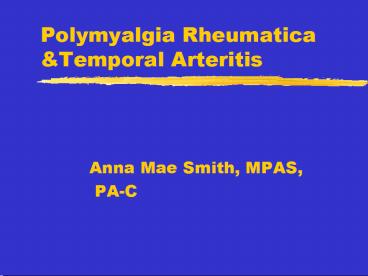Polymyalgia Rheumatica - PowerPoint PPT Presentation
1 / 33
Title:
Polymyalgia Rheumatica
Description:
A clinical syndrome characterized by aching and stiffness of ... Fibromyalgia. Depression. Polymyositis/dermatomyositis (check CPK, aldolase) Thyroid disease ... – PowerPoint PPT presentation
Number of Views:1745
Avg rating:3.0/5.0
Title: Polymyalgia Rheumatica
1
Polymyalgia Rheumatica Temporal Arteritis
- Anna Mae Smith, MPAS,
- PA-C
2
Polymyalgia Rheumatica
- A clinical syndrome characterized by aching and
stiffness of the shoulder and hip girdle muscles
affecting older patients, associated with an
elevated ESR, lasting over 1 month and responsive
to low dose steroids
3
Epidemiology
- Incidence/Prevalence in USA Approximately
50/100,000 patients over age 50/year - Predominant age 60 or older. Incidence increases
with age (rare under 50 years old). - Predominant sex Females Male (21)
4
Signs Symptoms
- Onset - abrupt or insidious
- Pain and stiffness shoulder and hip girdle
- Usually symmetrical
- Symptoms more common in the morning
- Gel phenomena (stiffness after prolonged
inactivity) - Constitutional symptoms - fatigue, malaise,
depression, weight loss, low grade fever
5
Signs Symptoms
- Arthralgias/arthritis (non inflammatory)
- No weakness (pain may limit strength)
- Muscle tenderness mild to moderate
- No muscle atrophy
- Decreased range-of-motion of joints on active
motion usually due to pain - May have signs and symptoms of giant cell
arteritis
6
RISK FACTORS
- Age greater than 50
- Presence of giant cell arteritis
7
(No Transcript)
8
(No Transcript)
9
Differential Diagnosis
- Rheumatoid arthritis
- Other connective tissue disease
- Fibromyalgia
- Depression
- Polymyositis/dermatomyositis (check CPK,
aldolase) - Thyroid disease
- Viral myalgia
- Osteoarthritis
10
Differential Diagnosis
- Occult infection
- Occult malignancy (extensive search usually not
necessary) - Myopathy (steroid, alcohol, electrolyte
depletion)
11
LABS
- ESR (Westergren) elevation greater than 50
- Anemia - normochromic/normocytic
- Creatine phosphdkinase (CPK)- normal
- Rheumatoid factor (RF) - negative (5-10 patients
over 60 will have positive RF without disease) - Mild elevations in liver function tests
12
TREATMENT
- Physical therapy for range-of-motion exercises if
necessary - Do not over exercise to cause exertion
- Precautions regarding steroid use
- Instruct the patient about symptoms of giant cell
arteritis and to report them immediately
13
TREATMENT - Prednisone
- 10 mg/day initially (average initial affective
dose 10-15 mg/d) - Usually dramatic (diagnostic) response.
- May increase gradually to 20 mg if no response
- Begin slow taper at 4-6 weeks by only 1 mg every
1-4 weeks to a dose of 5-7.5 mg. Continue at this
dose for approximately 18 months to 2 years, if
no recurrence of symptoms.
14
TREATMENT - Prednisone
- Then attempt to taper by 1 mg every 2-4 weeks
until drug discontinued. Patient may, however,
require steroids for 3 or more years. - Increase prednisone for recurrence of symptoms
(relapse common)
15
Patient Follow -up
- Follow monthly initially and during taper of
medication, every 3 months otherwise - Follow ESR as steroids tapered
- Followup with patient for symptoms of giant cell
arteritis. Educate patient to report such
symptoms immediately (headache, visual and
neurologic symptoms)
16
PROGNOSIS
- Average length disease is 3 years (range 1-5
years) - Exacerbation if steroids tapered too fast
- Prognosis very good if treated (may gradually
remit even if no treatment) - Relapse common
17
Henoch-Schonlein Purpura
18
Definition
- A vasculitis of small vessels characterized by
nonthrombocytopenic, usually dependent, palpable
purpura, arthritis, abdominal pain and nephritis
19
Epidemiology
- Incidence/Prevalence in USA Incidence 14/100,000
in 2-14 year old age range. Seasonal variation -
more common in winter. - Predominant age Most occur between 2-8 years
old, but can occur at any age - Predominant sex Male Female (21)
20
SIGNS Symptoms
- Onset can be acute or gradual
- 50 of patients have malaise and low grade fever
- Skin lesions occur in all identified patients
- Lesions appear on lower extremities and buttocks
but may involve face, trunk and upper extremities
- Begin as small wheals or erythematous
maculopapular
21
(No Transcript)
22
SIGNS Symptoms
- Lesions blanch on pressure but later become
petechial or purpuric - Lesions appear in crops
- Angioedema of scalp, lips, eyelids, ears, dorsa
of hands and feet, back, scrotum and perineum may
be seen
23
(No Transcript)
24
SIGNS Symptoms
- Two-thirds of patients experience arthritis
- Large joints (knees and ankles) are most commonly
involved
25
SIGNS Symptoms
- One-half of patients experience GI symptoms
- Colicky abdominal pain associated with vomiting
is most common - Occult or gross blood in stool
- Hematemesis
- Intussusception, obstruction or infarction rarely
occurs - Pancreatitis
26
SIGNS Symptoms
- Renal involvement is less common
- Hematuria, with or without casts or proteinuria
27
SIGNS Symptoms
- Other manifestations
- Seizures, neuropathies
- Hepatosplenomegaly
- Lymphadenopathy
- Cardiac involvement
- Pulmonary hemorrhage
- Rheumatoid-like nodules
28
DIFFERENTIAL DIAGNOSIS
- Hemorrhagic diathesis
- Septicemia
- Intussusception
- Acute appendicitis
- Acute glomerulonephritis
- Familial IgA nephropathy
- Polyarteritis nodosa
29
DIFFERENTIAL DIAGNOSIS
- Systemic lupus erythematosus
- Inflammatory bowel disease
- Subacute bacterial endocarditis
- Rocky Mountain spotted fever
- Thrombocytopenic purpura
30
Labs
- Not diagnostic
- Sedimentation rate, white blood cell count may be
elevated - Coagulation studies, platelet count and
complement determinations are normal - Serum IgA elevated in 50
- Urinalysis shows protein, red blood cells, white
blood cells if renal
31
TREATMENT
- Anti-inflammatory agents may be used for
arthritis and fever - Corticosteroids (prednisone 1-2 mg/kg/day) for
severe GI symptoms and/or painful angioedema.
Corticosteroids do not alter the progression of
the lesions.
32
COMPLICATIONS
- Hypertension
- Renal failure
- Intestinal hemorrhage
- Bowel obstruction or perforation
- Death very rare
33
PROGNOSIS
- Disease may last for a few days with transient
arthritis however, in many cases, the average
duration is 4-6 weeks - Occasionally recurrent
- 25 of patients with initial renal involvement
will have persistently abnormal urine sediment































